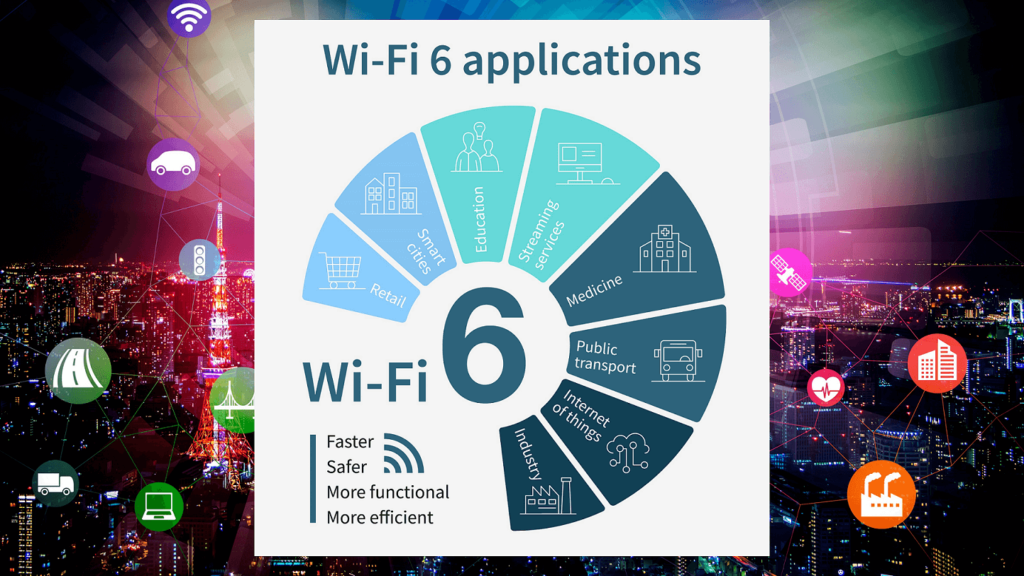In today’s highly digital world, innovative devices and applications that re-shape the landscape become available with every passing day. The next revolutionary piece of technology is just around the corner, with the emergence of Wi-Fi 6 gaining hype quickly. Wi-Fi 6 is the next generation of Wi-Fi, meaning it’ll still do the same basic thing, simply more efficiently, while speeding up connections in the process.
In short, Wi-Fi 6 is 9.6 Gbps, a whole 3.5 Gbps more than Wi-Fi 5. The new generation improves speeds over its predecessor by 37 percent, offering faster internet for all connected devices, and coming with more bandwidth for traffic, which is like expanding a two-lane highway to six lanes.
The security update that comes with Wi-Fi 6 is also one of the most significant benefits the technology has to offer. It’s now much more difficult for a hacker to run an offline cracking program to try to gain entry into a network. Sessions are also encrypted, so users can connect more securely to a free public Wi-Fi without worrying about a hacker being able to spy on their traffic.
In preparation for the game-changing technology, organizations have already begun purchasing the necessary equipment for adequately deploying and leveraging Wi-Fi 6. The global Wi-Fi 6 and Wi-Fi 6E chipset market size was valued at USD 6.47 billion in 2020 and is expected to expand at a compound annual growth rate (CAGR) of 19.7 percent from 2021 to 2028.
Wi-Fi 6, like other new technologies, can also be improved when used in combination with other devices and applications. For Wi-Fi 6, the most notable pairing in terms of enhancement of benefits is with 5G.
5G is expected to greatly change the way businesses work and the way people live, being faster and able to handle more connected devices than the existing 4G LTE network. The fifth-generation wireless technology offers extremely low latency rates, which make for faster, smoother, and more reliable connections.
While 5G networks began rolling out in the United States and around the world in 2018, the tech is still in its early days, but experts say the potential is huge. That’s because the benefits of the new technology are expected to fuel transformative new technologies, not just for consumers but also for businesses, infrastructure, and defense applications. By the end of 2024, there are projected to be 1.5 billion 5G mobile subscriptions, as the network is predicted to cover 40 percent of the world and handle 25 percent of all mobile traffic data in the same period of time.
“Of course, no one is going to doubt the potential these technologies have on their own, but when leveraged in unison, the impact the technology could have is massive,” said Don DeLoach, founder and CEO of Rocket Wagon Venture Studios. “They both offer low latency, fast data rates, higher capacity, and high performance, but with 5G on a cellular front, the technology is more suited for large range operations. Companies with large outdoor operations might consider 5G for their network needs, while with indoor operations or determined access points, enterprises can take advantage of the features of Wi-Fi 6E for their 6 GHz-enabled devices and equipment.”
The combination will also be powerful in the manufacturing sector, helping facilitate and usher in a new era of Industry 4.0. The advanced wireless networks of 5G and Wi-Fi 6 play a critical role in linking machines and devices to drive smart factory solutions. They will ensure seamless tracking of the products in an assembly line, collect huge amounts of data to predict production patterns as per demand, and maintain quality control and standardization. Because it is super reliable and offers low latency, 5G can drive flexible human-robot interactions to replace slow wired connections.
“Progress with technology is inevitable, as we have seen for years,” DeLoach said. “However, as we continue to progress to a hyperconnected world, it is increasingly important to view technological advances holistically in the context of other advances and overall system optimization. A great example of this is the combination of 5G and Wi-Fi 6, especially considering the myriad of connected devices and interrelated systems.”
Even more, with 5G and Wi-Fi 6 working in tandem, the healthcare sector can introduce remote surgeries and remote diagnosis making facilities available for all. Transmission of health records for detection at early stages will become a part of the way the industry works.
Finally, with the increase in e-commerce, the entire structure depends on Supply chain companies. The introduction of 5G and Wi-Fi 6 can be a real game-changer for the last mile interaction with the end consumer. Apart from making logistics operationally efficient, personalized and enhanced customer experience can be achieved.
Overall, businesses will benefit from what 5G and Wi-Fi 6 have to offer to a range of industries and a broader array of applications, from media, transportation, and healthcare to agriculture, manufacturing, and logistics. 5G and Wi-Fi 6, while they both excel on their own, together offer connectivity that can be revolutionary for both industrial use and consumers.
“5G alone solves a set of problems that are meaningful, as does Wi-Fi 6, but in combination, they will enable a host of solutions that provide faster, cheaper, smarter solutions, most notably one with autonomous capabilities ranging from cars to buildings to infrastructure, and more,” DeLoach explained.
“And of course, this is simply a point along a greater journey, but the importance of a holistic architectural vision will remain crucial.”
Originally published on 5G Evolution World
Arti Loftus is an experienced Information Technology specialist with a demonstrated history of working in the research, writing, and editing industry with many published articles under her belt.


